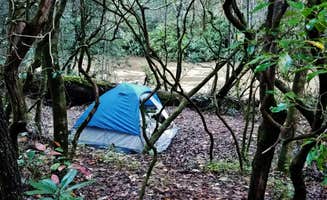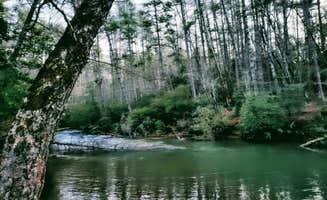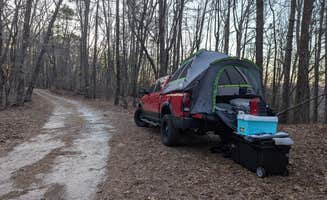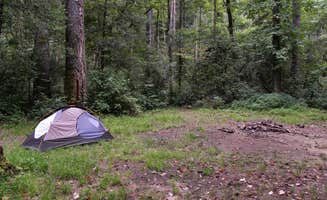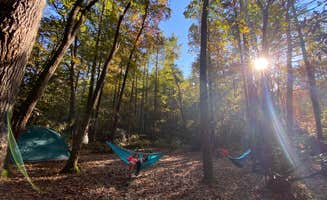Dispersed camping opportunities within Sumter National Forest provide rustic camping near Anderson, South Carolina with minimal facilities and maximum seclusion. Forest service roads throughout the area lead to primitive campsites where self-sufficiency is essential. Most sites are located between 30 and 45 miles from Anderson, primarily in the northern sections of the forest near the Chattooga River watershed.
What to do
**Fishing access: ** Several dispersed campsites offer direct access to year-round trout fishing. At Blackwell Bridge, campers can fish the Chauga River with "no lure or size restrictions" according to William S. The campsite is located "literally under a bridge" with quick river access.
Waterfall exploration: Hike to cascades directly from your campsite. At Mountain Rest Mountain Top, Claudia H. notes the site is "at trailhead of a trail down to creek and near a second trail to a waterfall." Most hiking trails are moderate difficulty with distances under 3 miles round-trip.
River camping: Set up your tent directly beside flowing water. Sandy Beach Campsite offers exactly what the name suggests. Alex R. confirms "you're on the beach" with your tent positioned "right next to the Chattooga river." This hike-in site requires carrying all your gear approximately 1-2 miles.
What campers like
Natural soundscapes: The rushing water creates a peaceful camping environment. At Falls Creek, Brian notes it's a "nice secluded spot" where the "river is about .6 mile hike away." Most campsites are positioned to maximize the sounds of flowing water while minimizing road noise.
Night sky viewing: Minimal light pollution creates excellent stargazing conditions. Sara S. from Mountain Rest Mountain Top mentions there's a "great view of the stars during early spring/late winter" and the area is "dead silent and relaxing." Clear nights reveal impressive celestial viewing, especially during new moon phases.
Island camping experience: For a truly unique primitive camping experience, Goat Island offers boat-in camping with unusual amenities for dispersed sites. Jay J. explains "there are picnic tables and fire pits at each site, but no other accommodations" and "the light pollution is at a minimum for the lake so it's beautiful and very secluded at night."
What you should know
Vehicle requirements: Forest roads demand appropriate vehicles with decent ground clearance. While some reviewers suggest 4WD, others have managed with careful driving. Zoey W. notes about Mountain Rest Mountain Top: "you dont need 4 wheel drive or a truck like some of these people are saying, i did it fine in my honda civic, just dont have anything with worse clearance than that."
Finding your site: Some dispersed camping areas can be difficult to locate, especially with limited cell service. For Blue Valley Dispersed Camping, Garnet B. shares specific directions: "From Highlands, follow NC 28 south about 5.5 miles and turn right onto Blue Valley Rd. (S.R. 1618) at the sign. The pavement will end in a half mile. Just stay on the main path for just little over 3 or so miles."
Weather variability: Mountain elevations cause significant temperature fluctuations. Linda F. reported about Blue Valley: "I went in July and it was cool in day and cold at night." Pack layers even during summer months when overnight lows can drop into the 50s.
Tips for camping with families
Space considerations: Look for sites with room for exploration. About Blue Valley, Kristin S. mentions "beautiful, large, private sites. You couldn't see our site from the road, huge site, lots of woods surrounding for kids to play and explore, right beside a gorgeous large creek."
Site selection: Choose established areas with existing amenities. Alex T. notes Blue Valley has "8 very well kept campsites. Almost all near a creek of some sort. Hiking trails near by... Room for larger groups ~40 people max for the biggest site ~6 for the smallest."
Creek access: Water features provide natural entertainment for children. Many sites are positioned near shallow, accessible water. When visiting dispersed sites, bring water shoes and supervise children near any flowing water.
Tips from RVers
Size limitations: Most dispersed sites accommodate only smaller RVs and trailers. Tent camping is the predominant option, though some areas can fit modest-sized recreational vehicles. Access roads often have overhanging branches and tight turns.
Site conditions: Be prepared for uneven parking areas. Myron C. describes King Creek: "King Creek is accessible via a short drive along a forest road and then another short drive down a muddy road slightly overgrown with vegetation... It is NOT for RVs. First of all, the road is narrow and vegetation hangs low along the road. It is uneven and sometimes muddy."
Supply planning: No hookups or facilities exist at these primitive sites. Pack in all necessary water, waste containers, and power sources. Most locations are 15-20 miles from the nearest supplies, so thorough preparation is essential.


